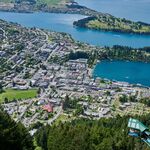Toronto is a bus to subway transfer city, and if this LRT is not time competitive, people will take a another parallel bus to connect to the subway.
No offense, but this seems like a highly overstated concern. Having their own lanes, even if they are not accompanied by grade separation, already makes the LRT more time competitive than the Eglinton East bus, and the assertion that "people will take another parallel bus to connect to the subway" falls apart when one actually considers the alternatives presented to them. Lawrence East is too far to the north to make it a viable alternative (2.5 km - no one in their right mind is going to choose this option when they have a frequent LRT much closer to them), and fairly slow; and there is nothing south of Eglinton that would constitute a quick ride to the subway. Any cross street such as Warden or Victoria Park has to contend with buses not running in their own private lanes; there is zero chance of any of these buses being competitive to the LRT under the current road design.
Your point about alternatives can only be true if the person lives within walking distance of the Eglinton & Kennedy intersection, and has a choice of whether to connect to the 2 or 5. And even then, that presumes that everyone living along this corridor is only using the LRT as a means to connect to the Yonge subway instead of any local destinations along Eglinton.
Ion has some of the max priority for surface lrts in Canada(boom gates) and still gets major collisions
It's not like the subway has never shut down for anything, though. The fact of life is that sometimes, shit happens and our transit system suffers as a result. That doesn't mean we shouldn't try to avoid that, wherever possible, but we should be realistic about what we are concerned of happening and what we can realistically do to prevent it. Let's say we built a grade-separated LRT; this could still be shut down in the event of a power outage, icy weather, vehicle-passenger collision, damaged power collection system, derailment (all things that could also happen on a subway), or, with the elevated guideway, you now also introduce the additional risk of a vehicle down below colliding with it. Now you have to suspend service while the structure is examined to make sure it's safe.
Surface running LRTs in street medians have their time and places, namely in dense downtown cores where people are travelling short distances - certainly not large crosstown routes that are mostly grade separated anyway, where the at grade segment does nothing but weakens the rest of the line. The problem with Toronto's LRTs isn't that they're building LRTs at all, but they're building them in the wrong places, and it's the wrong mode for what they want to do.
Having ridden on street median running crosstown trams in Europe (and not always with functioning transit priority either!), I find this assertion to be dubious. The simple fact of not sharing lanes with traffic alone makes the ride significantly faster than it otherwise would be.
I find the concerns about the lack of transit priority to be highly overstated. Is it an embarrasment to Toronto? Yes. Is it going to make the ride a bit slower and more annoying? Yes. Should the person who suggested this have been fired many years ago? Yes. Is the world going to end over it? No. Does it justify spending millions and millions more on constructing elevated guideways and then maintaining them? I certainly don't think so.




